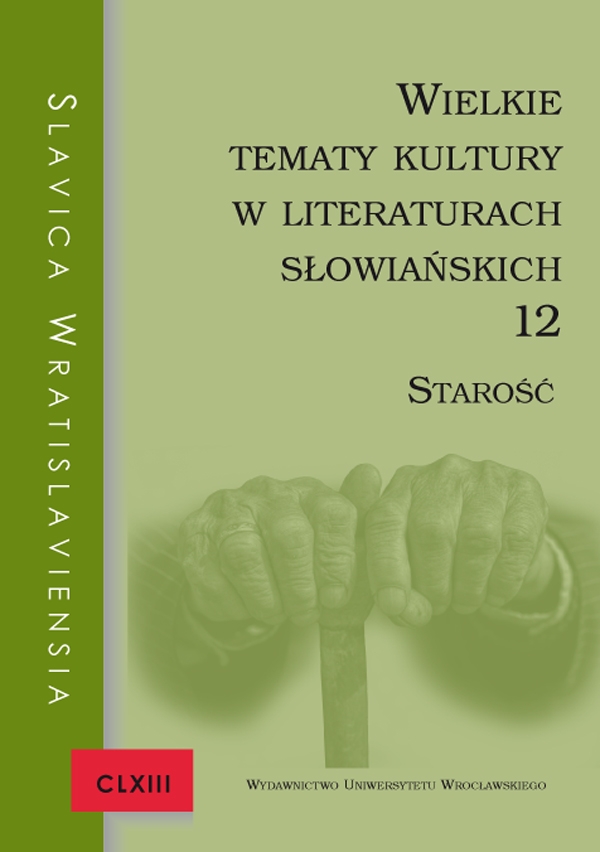

Artykuły

Artistic patterns of old age expression in the works by Slovak authors Milo Urban, Július Barč-Ivan,Karol Horák
The cultural and social phenomenon of old age as an object of artistic literature from middle ages till contemporary period has been interpreted mostly ambivalently as asource of the wisdom as well as the weakness, experience and psychic degradation, the loss of authority and suffering. Within the various poetic methods realizing in the world and European literary production including Slovak literature, the rich reflections and different artistic patterns of an old age expression can be found. To manifest various forms of this cultural and social phenomenon in the literature three works from different social and historical periods representing various development stages of the Slovak literature will be analysed — the novella Staroba “Old Age” from the collection Výkriky bez ozveny “Yells without Echoing”, 1928 written by the prosaic writer and journalist Milo Urban, the tragedy Matka “Mother” written by prosaic and drama writer Július Barč-Ivan, and the play Cesta “Journey” written by prosaic and drama writer, literary and theatre scientist, university professor Karol Horák. The given texts prosaic one and two dramatic ones are integrated by common milieu with identical archetypal value — the world of Slovak village which is often described in the works by Slovak authors.
Whereas the protagonist of the first work is an old village man tossing up between passionate desire to live and the awareness of the death inevitability, in the second and third work the key role is played by older women fulfilling their role of mothers. In Barč´s drama the mistaken fatalistic faith in predetermination of human fates leads towards the religious negativism and becomes the source of evil criminal act. As opposed to Barč´s play Matka the protagonist of Horák´s play Cesta, Kata Pohlodková, believes in the better future on the basis of Christian philosophy. The author stratifies his narration to produce the inward portrayal of aman in the extreme life situation on the background of historical events. Taking into consideration the miscellaneous aspects of this phenomenon, the research of this topic in the literary works is still open provoking the questions like — In which way is life represented in the literature through this phenomenon? Is this phenomenon presented stereotypically or are the generally valid stereotypes overcome? What is the influence of this phenomenon on aman and his/her attitude towards life transience?
It can be generally accepted that the phenomenon of old age intervenes into human life and modifies it in abig way.
Artystyczne ujęcie zjawiska starości w twórczości wybranych autorów słowackich Milo Urban, Július Barč-Ivan, Karol Horák
Społeczno-kulturowy fenomen starości w literaturze artystycznej od średniowiecza aż po współczesność interpretowany jest ambiwaletnie: z jednej strony jako źródło mądrości i doświadczenia, z drugiej zaś jako czas słabości, degradacji psychicznej, utraty autorytetu oraz cierpienia. W literaturze światowej, europejskiej, więc również, co oczywiste, w kontekście słowackim, stosunkowo często spotykamy się z refleksją na temat ostatniej fazy życia człowieka i z jej różnorodnym artystycznym opracowaniem. Za ilustrację możliwych literackich ujęć owego zjawiska posłużyły nam trzy dzieła autorów piszących po słowacku: nowela Staroba Starość ze zbioru Výkriky bez ozveny 1928; Okrzyki bez echa prozaika, tłumacza i dziennikarza Mila Urbana, tragedia Matka 1943 prozaika i dramatopisarza Júliusa Barča-Ivana oraz sztuka Cesta 1988; Droga dramatopisarza, prozaika, teatrologa i literaturoznawcy — profesora Karola Horáka. Wybrane utwory jeden prozatorski, dwa dramatyczne łączy pewien element archetypiczny — topos wsi słowackiej, skądinąd silnie obecny w rodzimej literaturze.
Głównym bohaterem tekstu prozatorskiego jest uwięziony między pragnieniem życia a świadomością nieuniknionej śmierci mężczyzna, natomiast w przypadku dramatów kluczową rolę odgrywają starsze kobiety — matki. W dramacie Júliusa Barča-Ivana ślepe przekonanie o nieodwracalności ludzkiego losu prowadzi do zaprzeczenia religii i— w ostateczności — do zbrodni. Inaczej jest u Karola Horáka. Protagonistka sztuki Cesta Kata Pohlodková zgodnie z duchem filozofii chrześcijańskiej wierzy w lepszą przyszłość. Swoją opowieść autor wzbogaca, na tle wydarzeń historycznych pokazując introspektywę bohatera, który znalazł się w tragicznej sytuacji życiowej.
Należy pamiętać o tym, że szeroki horyzont omawianego zjawiska, również dzięki jego wieloaspektowości, nie ogranicza pola badawczego, lecz wręcz przeciwnie — prowokuje do dalszych odkryć oraz prób odpowiedzi na liczne pytania. Bardzo interesująca wydaje się na przykład kwestia rzutowania starości na wizerunek życia w literaturze pięknej. Czy przedstawianie starości podlega powszechnie przyjętemu stereotypowi, czy mu się opiera, przełamuje go? Jaki wpływ ma starość na człowieka i świadomość przemijania? I tak dalej.
Z pewnością jednak można stwierdzić, że omawiane przez nas zjawisko determinuje człowieka, określając i formując jego los.